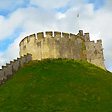TANGMERE MILITARY AVIATION MUSEUM
RAF Battle of Britain Airfield in South England
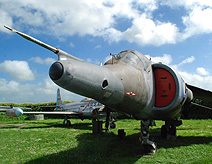 RAF Tangmere had a long and illustrious history in two world wars, a forward base in the Battle of Britain, home to flying aces and aircraft speed records in the post war. Located near the town of Chichester in West Sussex, close to the south coast, the Tangmere Aerodrome was first operational in 1917 as a training airfield, first for the Royal Flying Corps, then in 1918 as a training field for the American Air Corps entering the war. As headquarters for No 11 Group of Fighter Command in 1940 during the Battle of Britain, the base was a prime target for Stuka dive bombers. England’s highest scoring ace Johnnie Johnson flew from the airfield and it was also the base for perhaps the most famous of British war aviators, Douglas Bader, who flew his missions despite have lost both legs.
RAF Tangmere had a long and illustrious history in two world wars, a forward base in the Battle of Britain, home to flying aces and aircraft speed records in the post war. Located near the town of Chichester in West Sussex, close to the south coast, the Tangmere Aerodrome was first operational in 1917 as a training airfield, first for the Royal Flying Corps, then in 1918 as a training field for the American Air Corps entering the war. As headquarters for No 11 Group of Fighter Command in 1940 during the Battle of Britain, the base was a prime target for Stuka dive bombers. England’s highest scoring ace Johnnie Johnson flew from the airfield and it was also the base for perhaps the most famous of British war aviators, Douglas Bader, who flew his missions despite have lost both legs.
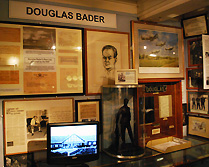 Flying Wing Commander Douglas Bader arrived at RAF Tangmere in March 1941. It was a new post created in Fighter Command for Bader who had come from Duxford (see Imperial Air Museum Duxford). The Tangmere Wing of Spitfires provided cover for the bomber “Circus” across the French coast. Bader’s time at Tangmere would end in August on 1941, when he bailed out of his shot up plane over the French coast. Captured by the Germans and after a visit with an admirer, Adolph Galland, in Paris, would spend the rest of the war in a German Prison camps while bedeviling the German High Command with escape attempts (see Colditz Castle POW Escapes). Also held at Colditz prison was Sergeant Geoffrey Hill, who served in 65 Squadron, shot down in February of 1941, who recently donated a model of his Spitfire made by a fellow Australian prisoner to the museum. Tangmere played a role in the Dam Busters bombing raids of 1943 and also served as a secret station for the Special Operations Executive, delivering agents in and out of France to support the Resistance. After the Second World War Tangmere served as the center for RAF High-Speed Flight testing ground for the advancement of British military aviation, seeing two world air speed records set over its fields. The base closed operations in 1970.
Flying Wing Commander Douglas Bader arrived at RAF Tangmere in March 1941. It was a new post created in Fighter Command for Bader who had come from Duxford (see Imperial Air Museum Duxford). The Tangmere Wing of Spitfires provided cover for the bomber “Circus” across the French coast. Bader’s time at Tangmere would end in August on 1941, when he bailed out of his shot up plane over the French coast. Captured by the Germans and after a visit with an admirer, Adolph Galland, in Paris, would spend the rest of the war in a German Prison camps while bedeviling the German High Command with escape attempts (see Colditz Castle POW Escapes). Also held at Colditz prison was Sergeant Geoffrey Hill, who served in 65 Squadron, shot down in February of 1941, who recently donated a model of his Spitfire made by a fellow Australian prisoner to the museum. Tangmere played a role in the Dam Busters bombing raids of 1943 and also served as a secret station for the Special Operations Executive, delivering agents in and out of France to support the Resistance. After the Second World War Tangmere served as the center for RAF High-Speed Flight testing ground for the advancement of British military aviation, seeing two world air speed records set over its fields. The base closed operations in 1970.
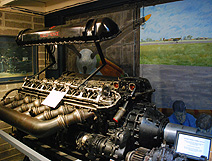 The Tangmere Military Aviation Museum was founded to maintain the memory of the United Kingdom’s contributions to military aviation and its unique place in wartime history. The air field landing strips and base have long since returned to farmlands and the museum takes up a somewhat cramped remaining building of the former air station and two mock hangers. The museum’s collection of aircraft is mostly post WWII. It has a Prototype Supermarine Spitfire and a Hawker Hurricane from the Secord World War period, but rarer are the world speed record setting Gloster Meteor F4 flown by Group Captain “Teddy” Donaldson in 1946 and the Hawker Hunter which set the record in 1953 flown by Neville Duke.
The Tangmere Military Aviation Museum was founded to maintain the memory of the United Kingdom’s contributions to military aviation and its unique place in wartime history. The air field landing strips and base have long since returned to farmlands and the museum takes up a somewhat cramped remaining building of the former air station and two mock hangers. The museum’s collection of aircraft is mostly post WWII. It has a Prototype Supermarine Spitfire and a Hawker Hurricane from the Secord World War period, but rarer are the world speed record setting Gloster Meteor F4 flown by Group Captain “Teddy” Donaldson in 1946 and the Hawker Hunter which set the record in 1953 flown by Neville Duke.
Museum Halls
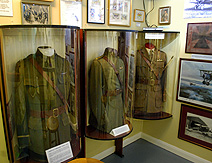 The Battle of Britain Hall focuses on the airfield’s role in the battle for the skies over the southern coast in 1940, with photographs and documents from fliers, the signatures of many of the Battle of Britain pilots who flew from Tangmere, a collection of reconnaissance cameras, a display of a number for captured Luftwaffe artifacts, the uniform of Victoria Cross earning Lt James Nicholson, and the recovered remains of crashed aircraft engines and the Hurricane Dennis Noble.
The Battle of Britain Hall focuses on the airfield’s role in the battle for the skies over the southern coast in 1940, with photographs and documents from fliers, the signatures of many of the Battle of Britain pilots who flew from Tangmere, a collection of reconnaissance cameras, a display of a number for captured Luftwaffe artifacts, the uniform of Victoria Cross earning Lt James Nicholson, and the recovered remains of crashed aircraft engines and the Hurricane Dennis Noble.
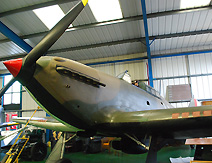 The Middle Hall presents a collection of RAF Regiment armaments, of the Mohne Dam, the first dam bombed in 617 Squadron’s raid in 1943 along with models of the dam busting Lancaster and a working model of the unique mechanism used to spin the bombs before dropping to bounce along the water surface and sink against the dam. There is also a display of life on the Home Front, and a collection of pilot logbooks.
The Middle Hall presents a collection of RAF Regiment armaments, of the Mohne Dam, the first dam bombed in 617 Squadron’s raid in 1943 along with models of the dam busting Lancaster and a working model of the unique mechanism used to spin the bombs before dropping to bounce along the water surface and sink against the dam. There is also a display of life on the Home Front, and a collection of pilot logbooks.
Tangmere Hall features exhibits telling the story of the base history from 1917 to 1970, with special sections on the Royal Flying Corps of the first world war before the RAF, the special equipment and techniques of Special Operations agents (see SOE Spy School Beaulieu) and the Lysander pilots who flew them to and from occupied France, a collection of radio equipment, displays of medals and a number of original aircraft oil paintings.
Aces: A Novel of Pilots in the Battle of Britain from Both Sides
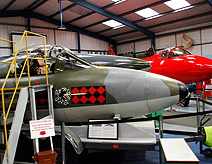 Merston Hall in the style of an aircraft hangar houses the Museum’s two world airspeed record Meteor and Hunter aircraft, along with the (replica) WWII era Spitfire and Hurricane, a Supermarine Swift, a Canberra cockpit, cutaway jet engines, ejector seats and three of the museum’s simulators, some just for kids to fly.
The newest Hall at the museum, the Meryl Hansed Memorial Hall, is focused on the museum’s current preservation efforts, restoring the Hunter Mk 5 and the English Electric Lightning F53 donated by Raymond Hansed in honor of his late wife. In the Reception area is a collection of United States memorabilia and an introductory video presentation, and outside is a memorial garden, picnic area and part of an air raid shelter.
Merston Hall in the style of an aircraft hangar houses the Museum’s two world airspeed record Meteor and Hunter aircraft, along with the (replica) WWII era Spitfire and Hurricane, a Supermarine Swift, a Canberra cockpit, cutaway jet engines, ejector seats and three of the museum’s simulators, some just for kids to fly.
The newest Hall at the museum, the Meryl Hansed Memorial Hall, is focused on the museum’s current preservation efforts, restoring the Hunter Mk 5 and the English Electric Lightning F53 donated by Raymond Hansed in honor of his late wife. In the Reception area is a collection of United States memorabilia and an introductory video presentation, and outside is a memorial garden, picnic area and part of an air raid shelter.
On the outdoor grounds of the museum around the parking area is a static display of seven of the historic aircraft from the jetage at the base in the 1950s and 60s including a McDonnell Douglas Phantom FGR2, a De Havilland Sea Vixen, Sea Harrier FRS2, Lockheed T-33 trainer, De Havilland Vampire T11, Gloster Meteor F8, Westland Wessex Helicopter and Hawker-Siddeley Harrier GR3.
Visiting RAF Tangmere Military Air Museum
The Museum is located in the village of Tangmere, 3 miles to the west of Chichester off the A27 road to Arundel Castle (see Arundel Castle and Gardens). It is open every day between February 1 and November 30. Hours are 10am to 5:30pm from March to October and 10am to 4:30pm in February and November. Admission is £9 for adults, £7 for seniors over 60 and service personnel with ID, £3 for children 5 to 16 and children under 5 are free. There is a family ticket for £21. There is a public bus service line 55 from Chichester bus station daily. © Bargain Travel Europe
Find best hotel and travel deals in Arundel on TripAdvisor
Web Info
Tangmere Museum
These articles are copyrighted and the sole property of Bargain Travel Europe and WLPV, LLC. and may not be copied or reprinted without permission.
SEE ALSO:
BEAULIEU NATIONAL MOTOR MUSEUM
THE RIFLES REGIMENTAL MUSEUM SALISBURY
BRUNEL'S SS GREAT BRITAIN SHIP - BRISTOL
STONEHENGE - NEOLITHIC MYSTERY OF WILTSHIRE
ACES NOVEL OF BATTLE OF BRITAIN
CHURCHILL MUSEUM AND CABINET WAR ROOMS
HMS BELFAST WAR SHIP MUSEUM LONDON

